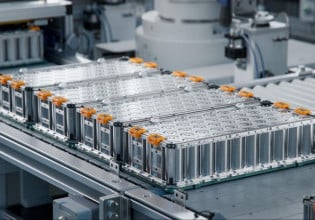Korean Researchers Pave Path Forward for Emerging Form of Energy Storage
A breakthrough might solve issues surrounding redox-enhanced electrochemical capacitors.
With heightening concerns around the environment and the worldwide usage of fossil fuels, the race to transition to renewable energy has never felt more urgent. To make this a reality, there is a significant need to improve energy storage technologies which will serve as the backbone of these systems.
Renewable energy transition. Image used courtesy of Adobe Stock
Within this, one form of energy storage that has been garnering researchers’ interest in recent years has been redox-enhanced electrochemical capacitors (redox ECs). Still, like any emerging technology, redox ECs have some technical shortcomings that need to be resolved before they can significantly impact the industry.
Recently, researchers from Korea have published a new research paper in which they developed an approach for enhancing the performance of redox ECs. Here, we’ll discuss redox ECs, their shortcomings, and how Korean research hopes to solve these challenges.
Redox Electrochemical Capacitors
Redox ECs are a special form of capacitor that merges the best features of both capacitors and batteries to provide a new, high-performance, high-capacity energy storage form.
At their core, redox ECs consist of two main components: an electrode and an electrolyte. The electrodes are typically made of a high-surface-area material, such as activated carbon or graphene, which provides a large area for charge storage–translating into a large storage capacity. On the other hand, the electrolyte contains redox-active species, such as metal ions or organic compounds, which undergo reversible reduction and oxidation (i.e., redox) reactions during the charge and discharge process.
Redox EC during a discharge phase (left); Redox EC versus a standard double-layer capacitor (right). Image used courtesy of Evanko et al.
In a standard capacitor, the charge is stored through electrostatic charge separation. Thanks to the redox mechanism in a redox EC, the device stores charge as electrostatic charge separation and through faradaic charge transfer in the same manner as conventional batteries. The resulting combination of these technologies is a new device capable of fast response times and high power outputs, like a traditional capacitor, but can also have higher energy densities than traditional supercapacitors.
Thanks to this unique performance potential, many are praising redox ECs as a critical component for enabling the future of energy storage in applications like renewable energy systems.
New Redox EC Research
According to the researchers from the Gwangju Institute of Science and Technology (GIST), redox ECs have some technical shortcomings despite their potential. One of these shortcomings is that the redox-active organic species used in the electrolyte have limited solubility in water-based (aqueous) systems, which can lead to low energy densities. To this point, attempts to improve the aqueous solubility of these species have not yielded any promising results.
Fortunately, research from the GIST team could end that narrative. As described in their research paper in ACS Energy Letters, the researchers successfully increased the solubility of the redox-active species used in redox ECs through a hydrotropic-supporting electrolyte (HSE).
The HSE increased solubility up to 7x. Image used courtesy of Byeon et al.
The new electrolyte was created through a process known as hydrotopy, in which amphiphilic molecules are used to increase the solubility of the species through a decrease in component volume. Using the HSE, the team found that the solubility of hydroquinone (HQ) and anthraquinone-derivative (AQM-Br) both increased without any chemical functionalization by a magnitude of 7x and 3x, respectively.
According to the researchers, this marks a major milestone in redox ECs because it promises a future in which these devices can overcome their existing challenges of low energy density. They believe their research can be widely applied to other redox species, making it applicable to multiple applications.









